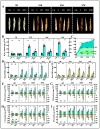Combined Physiological and Transcriptomic Analyses of the Effects of Exogenous Trehalose on Salt Tolerance in Maize (Zea mays L.)
- PMID: 39771205
- PMCID: PMC11676066
- DOI: 10.3390/plants13243506
Combined Physiological and Transcriptomic Analyses of the Effects of Exogenous Trehalose on Salt Tolerance in Maize (Zea mays L.)
Abstract
Soil salinization severely affects the quality and yield of maize. As a C4 plant with high efficiency in utilizing light and carbon dioxide, maize (Zea mays L.) is one of the most important crops worldwide. This study aims to investigate the pathways and mechanisms by which trehalose mediates the improvement of salt tolerance in maize through a combined analysis of physiology and transcriptomics. The results indicate that foliar application of trehalose treatment significantly increased maize biomass and antioxidant enzyme activity while reducing the H2O2 and Na+/K+ ratios in both the aerial and underground parts of the plant. Additionally, trehalose enhanced the total secretion of organic acids from maize roots, improving the soil microenvironment for maize growth under salt stress and alleviating Na+ toxicity. Transcriptomic data revealed that under salt stress, most differentially expressed genes (DEGs) were enriched in pathways related to photosynthesis, abscisic acid signaling, and sugar metabolism, and trehalose application increased the expression levels of these pathways, thereby mitigating the growth inhibition caused by salinity. This study elucidates mechanisms for enhancing salt tolerance in maize, providing theoretical support for improving its resilience and offering innovative strategies for utilizing a wide range of saline-alkali land.
Keywords: abscisic acid; antioxidant enzymes; maize (Zea mays L.); photosynthesis; salt stress; sugar metabolism; trehalose.
Conflict of interest statement
The authors declare no conflicts of interest.
Figures













Similar articles
-
The Physiological and Molecular Mechanisms of Exogenous Melatonin Promote the Seed Germination of Maize (Zea mays L.) under Salt Stress.Plants (Basel). 2024 Aug 2;13(15):2142. doi: 10.3390/plants13152142. Plants (Basel). 2024. PMID: 39124260 Free PMC article.
-
Insights into trehalose mediated physiological and biochemical mechanisms in Zea mays L. under chromium stress.BMC Plant Biol. 2024 Aug 17;24(1):783. doi: 10.1186/s12870-024-05514-6. BMC Plant Biol. 2024. PMID: 39152388 Free PMC article.
-
Bacillus atrophaeus WZYH01 and Planococcus soli WZYH02 Improve Salt Tolerance of Maize (Zea mays L.) in Saline Soil.Front Plant Sci. 2022 May 6;13:891372. doi: 10.3389/fpls.2022.891372. eCollection 2022. Front Plant Sci. 2022. PMID: 35599881 Free PMC article.
-
Advances in deciphering the mechanisms of salt tolerance in Maize.Plant Signal Behav. 2025 Dec;20(1):2479513. doi: 10.1080/15592324.2025.2479513. Epub 2025 Mar 18. Plant Signal Behav. 2025. PMID: 40098499 Free PMC article. Review.
-
Review: Trehalose and its role in plant adaptation to salinity stress.Plant Sci. 2025 Aug;357:112533. doi: 10.1016/j.plantsci.2025.112533. Epub 2025 Apr 29. Plant Sci. 2025. PMID: 40312014 Review.
Cited by
-
ZmPRR37-ZmYSL14 module enhances salt stress tolerance in maize.Theor Appl Genet. 2025 Jun 14;138(7):153. doi: 10.1007/s00122-025-04945-5. Theor Appl Genet. 2025. PMID: 40517178
References
-
- Rasheed A., Jie H.D., Ali B., He P.L., Zhao L., Ma Y.S., Xing H.C., Qari S.H., Hassan M.U., Hamid M.R., et al. Breeding Drought-Tolerant maize (Zea mays) using molecular breeding Tools: Recent advancements and future Prospective. Agronomy. 2023;13:1459. doi: 10.3390/agronomy13061459. - DOI
LinkOut - more resources
Full Text Sources
Research Materials
Miscellaneous

